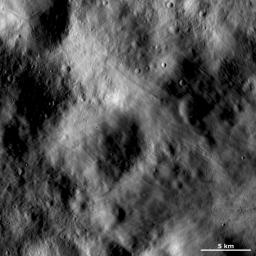
|
Grooved Surface and Area of Boulders
- Click the image above for a larger view
- Full-Res JPEG (1024 x 1024) (143.8 kB)
- Full-Res TIFF (1024 x 1024) (1.1 MB)
Caption:
This Dawn framing camera (FC) image of Vesta shows an area of the surface that is both grooved and smooth, which gives it an undulating appearance. The grooves run in many directions and are narrow, much less than 1 kilometer (0.6 mile) in width. There are many tiny craters, which are only a few hundred meters (hundreds of feet) in diameter, visible across this image. Small-scale features such as these are only visible in Dawn's high-resolution LAMO (low-altitude mapping orbit) orbit images. Another set of small-scale features is the cluster of boulders in the bottom right of the image. The boulders are distinguished from small craters because of the orientation of their shadows: the boulders cast shadows to the left because they are sticking out of the surface, while the craters cast shadows to the right because they are set into the surface.
This image is located in Vesta's Numisia quadrangle, near the Vestan equator. NASA's Dawn spacecraft obtained this image with its framing camera on Dec. 18, 2011. This image was taken through the camera's clear filter. The distance to the surface of Vesta is 272 kilometers (169 miles) and the image has a resolution of about 25 meters (82 feet) per pixel. This image was acquired during the LAMO (low-altitude mapping orbit) phase of the mission.
Background Info:
The Dawn mission to Vesta and Ceres is managed by NASA's Jet Propulsion Laboratory, a division of the California Institute of Technology in Pasadena, for NASA's Science Mission Directorate, Washington D.C. UCLA is responsible for overall Dawn mission science. The Dawn framing cameras have been developed and built under the leadership of the Max Planck Institute for Solar System Research, Katlenburg-Lindau, Germany, with significant contributions by DLR German Aerospace Center, Institute of Planetary Research, Berlin, and in coordination with the Institute of Computer and Communication Network Engineering, Braunschweig. The Framing Camera project is funded by the Max Planck Society, DLR, and NASA/JPL.
More information about the Dawn mission is online at http://www.nasa.gov/dawn and http://dawn.jpl.nasa.gov .
Cataloging Keywords:
| Name | Value | Additional Values |
|---|---|---|
| Target | 4 Vesta | |
| System | Main Belt | |
| Target Type | Asteroid | |
| Mission | Dawn | |
| Instrument Host | Dawn | |
| Host Type | Orbiter | |
| Instrument | Framing Camera (FC) | |
| Detector | ||
| Extra Keywords | Crater, Grayscale, Shadow | |
| Acquisition Date | ||
| Release Date | 2012-04-18 | |
| Date in Caption | 2011-12-18 | |
| Image Credit | NASA/JPL-Caltech/UCLA/MPS/DLR/IDA | |
| Source | photojournal.jpl.nasa.gov/catalog/PIA15556 | |
| Identifier | PIA15556 | |
